- mike@bitumenchem.com
- +86 15066607710
- Tongfa Avenue, Changqing District,Jinan
Location: Home > News & Trends > Industry News
Different types of modified bitumen (SBS modified bitumen, rubber bitumen and TPS modified bitumen) have the following main differences in composition and performance:
1. Composition: SBS modified bitumen: mainly uses styrene-butadiene-styrene (SBS) as a modifier, belongs to the thermoplastic rubber type, and has good elasticity and plasticity. Rubber bitumen: The main component is waste tire rubber, which uses its recycling characteristics and has low cost and environmental advantages. PS modified bitumen: uses thermoplastic rubber as the main component, and is combined with adhesive resin and plasticizer, specially designed for drainage bitumen pavement.
2. Performance: SBS modified bitumen: improves the rheological properties of bitumen, enhances viscoelasticity and ductility, improves impact resistance, crack resistance and wear resistance, and extends service life. Rubber bitumen: It also has high viscosity and good crack resistance, and by reusing waste tires, it complies with the policy of energy conservation and emission reduction. TPS modified bitumen: It has extremely high viscosity (up to 160,000 Pa·s) at 60°C, which plays a key role in improving the durability of drainage bitumen mixtures.
In terms of application areas and applicable conditions, the differences between various modified bitumens are as follows: SBS modified bitumen: It is mainly used in synchronous crushed stone seal, middle surface bitumen concrete and the upper layer of interchange ramps, and is suitable for pavements that require high impact resistance and wear resistance. Rubber bitumen: Due to its low cost and environmental protection characteristics, it is suitable for widespread use in highway construction, especially when the problem of recycling waste tires needs to be solved. TPS modified bitumen: It is specially used for drainage pavements, suitable for occasions that require good drainage performance, and can significantly improve the use effect of the construction site.
- Is the preparation method of SBS modified bitumen
- Can we predict the performance and stability of mo
- Advantages and Disadvantages of Segregation Test t
- BAC:Lower cost and higher reliability
- What are the conditions that affect the epoxidatio
- In the production process of rubber bitumen, the c
- What are the performance characteristics of modifi
- Why is excessive coupling agent the main cause of







